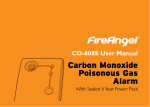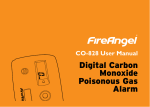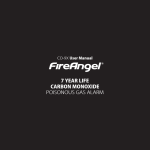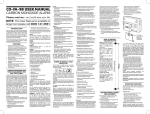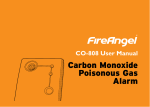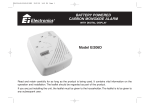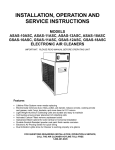Download NoCo Room Alarm Manual
Transcript
GN2210/R1 Carbon Monoxide Room Alarm Installation User Guide Part No: 7211368 Please read me - as I could save your life. CONTENTS INTRODUCTION FEATURES 4 INSTALLATION 6 INTERLINKING (“PAIRING”) THE CARBON MONOXIDE ALARMS TO THE NoCO CONTROL UNIT 6 TO TEST THE NoCO ALARMS ARE CORRECTLY ‘PAIRED’ AND HAVE CREATED A NETWORK 9 5 POSITIONING NoCO ROOM ALARMS 10 FITTING THE NoCO ROOM ALARM 13 TO TEST THAT THE NoCO ALARMS WILL SWITCH OFF THE BOILER IN THE PRESENCE OF A CARBON MONOXIDE LEAK 14 REMOVING YOUR NoCO ALARM FROM ITS BASE PLATE 14 WHAT WILL HAPPEN IN THE EVENT OF A CARBON MONOXIDE LEAK? 15 USER LOCK OUT 17 WHAT TO DO IN THE EVENT OF AN ALARM 18 2 USEFUL CONTACT NUMBERS 18 UNDERSTANDING THE PRODUCT INDICATORS (LEDS) 19 MAINTENANCE 20 TROUBLESHOOTING 21 LOW BATTERY ‘CHIRP’ SILENCE 22 DISPOSAL 22 WARRANTY AND SERVICE 23 CARBON MONOXIDE AND HOW IT CAN AFFECT YOU 25 3 INTRODUCTION Please keep this User guide in a safe place. If you move house, please hand it to the next occupier. The NoCO Carbon Monoxide Protection System is designed for use with gas or oil fired domestic boilers. When installed and interlinked with a NoCO Control Unit, as part of the NoCO Carbon Monoxide Protection System, this wireless carbon monoxide alarm will provide additional safety and peace of mind for you and your family. The carbon monoxide alarm will not only alert you with a loud audible signal in the event of a dangerous carbon monoxide leak but will also activate all other interlinked carbon monoxide NoCO alarms to signal the alarm. In addition, a wireless message will switch off your boiler in the event of a carbon monoxide leak for ultimate protection from this poisonous gas. Installing a NoCO Room alarm is ideal where the boiler is the only fuel burning appliance in the property. See “Interlinking (Pairing) NoCO Carbon Monoxide Alarms”, page 6 for further information about when it is recommended to interlink NoCO room alarms into a wireless network. Other Carbon Monoxide system components from NoCO Order Code: 7211367 Wireless Carbon Monoxide Alarm for a Void Order Code: 7211366 Carbon Monoxide System Control Unit 4 FEATURES • Detects carbon monoxide providing the earliest possible warning of toxic carbon monoxide levels from boiler flues or faulty fuel burning appliances. • Detects carbon monoxide continuously. • When installed with a NoCO Control Unit, as part of the NoCO Carbon Monoxide Protection System, this device will shut off the boiler in the event of a carbon monoxide leak. • Sounds a loud 85dB* alarm to alert you in case of an emergency. • Includes encoded wireless interlink to enable a network of carbon monoxide alarms, which will sound simultaneously in the event of a carbon monoxide leak. • 2 year warranty. Battery Activation/Automatic Power Engage Product lifespan is limited by the carbon monoxide sensor inside the alarm. This sensor will perform its function for seven years. After that point in time the NoCo Alarm units will need to be replaced. (The recommended date of replacement is printed on the side of the alarm unit) Your NoCO alarm comes complete with an integrated battery that will provide power for its entire seven year operational life. The battery is automatically enabled when the NoCO alarm is fully locked on to the mounting plate. It is disabled when removed from the mounting plate. When the NoCO alarm is activated the Power LED will begin to flash green once every minute to indicate that the NoCO alarm is receiving power from the battery and is fully operational. *at 1metre / 3 feet 5 INSTALLATION IMPORTANT: This NoCO Carbon Monoxide alarm must be linked to a NoCO Control Unit to create a Carbon Monoxide Protection System. Note: NoCO Room alarms should only be wirelessly interlinked (paired) with the NoCO Control Unit where there is no other fuel burning appliance within the property, to avoid the risk of nuisance boiler shut off where the source of carbon monoxide is not the boiler. It is recommended that the NoCO Control Unit is installed prior to fitting the NoCO alarm(s). Before installing the NoCO alarm into position, it is recommended to wirelessly interlink (“pair”) the NoCO alarm(s) to the NoCO Control Unit. INTERLINKING (“PAIRING”) THE CARBON MONOXIDE ALARMS TO THE NoCO CONTROL UNIT This NoCO alarm contains an inbuilt RF module, and enables you to wirelessly interlink two or more NoCO alarms and create a network. If one alarm activates, all other interlinked NoCO alarms will also sound. Therefore NoCO alarms need to be ”paired” or interlinked in order to communicate with each other. By “pairing” each NoCO alarm to the NoCO Control Unit, they will automatically be “paired” with all other units forming a wireless network. • NoCO Room alarms should be paired and interlinked to a NoCO Control Unit where there is a boiler, but no other fuel burning appliance within the property. • Where there are other fuel burning appliances (see page 10), there is a risk of nuisance boiler shut off where the source of CO is not the boiler. Therefore in this situation pairing is not recommended. 6 • All NoCO alarms which are not paired will act as a standalone alarm and will still sound if they detect CO, however, they will not switch off your boiler. • NoCO alarms can only be wirelessly interlinked with products from the NoCO Carbon Monoxide Protection System range. IMPORTANT For further information regarding wirelessly interlinking (pairing) your NoCO alarms, please contact NoCO Technical Helpline on 0844 41 2504 or www.no-co.co.uk. In the event of a service call required to reset your boiler from an alarm not caused by CO emitting from your boiler, your Gas Safe engineer may make a charge. Once the NoCO Control Unit is installed, temporarily place all the NoCO alarms to be installed within reach of the NoCO Control Unit. Read the following instructions carefully prior to “pairing” the NoCO alarms to the NoCO Control Unit. The “Pair” button is found on the back of the NoCO alarm (figure 1) Figure 1. 7 1. Using a biro, or opened out paper clip, press the “Pair” button of the NoCO alarm once, (with one short press). The red LED on the back of the alarm will flash and then illuminate for 5 seconds. Within this 5 seconds press the test button on the NoCO Control Unit. 2. The red LED on the back of the alarm will start to flash, confirming that the pairing has been successful. 3. The Alarm LED (red) and Fault LED (yellow) on the NoCO Control Unit will flash initially, but once the Control Unit has completed the initial pairing process, the LEDs on the Control Unit will stop flashing. 4. Repeat Steps 1 - 3 for additional alarms. Note: The Alarm LED (Red) will flash briefly each time you press the Control Unit test button during the pairing process.* 5. Fit the baseplates to the NoCO alarms 6. Once all the units are interlinked, the network will take a few minutes to establish. It is recommended to wait at least five minutes before testing the units (see page 9). Note, larger networks will take longer to establish. 7. Press the reset button on the NoCO Control Unit which will activate the NoCO Control Unit to standby mode. The Control Unit “Boiler Power” LED (green) will illuminate, showing there is mains power to the boiler. The NoCO Control Unit and NoCO Carbon Monoxide alarms have now been wirelessly interlinked to create a network. This means that in the event of a carbon monoxide leak the NoCO alarms will sound to warn you of the danger and your NoCO Control Unit will switch off your boiler. * Depending on how long the pairing of additional alarms takes, it is possible that the Control Unit will flash the fault LED (yellow). This is normal and will stop once Steps 5 - 7 are complete. 8 TO TEST THE NoCO ALARMS ARE CORRECTLY “PAIRED” AND HAVE CREATED A NETWORK Note: This test will confirm the pairing of the units into a network, but will not switch off the boiler. A: Testing the NoCO alarms: In order to be able to see the Control Unit indicators at the same time as pressing the Test button on the NoCO alarms, it is likely you will need two people to perform this operation. 1. Place the NoCO alarm onto its baseplate. 2. Press the test button on the NoCO alarm. 3. All paired NoCO alarms will sound a pattern of 2 x 4 short beeps and the Alarm LED (red) on the NoCO alarm will flash. 4. The Alarm LED (red) on the NoCO Control Unit will flash for 60 seconds. If the Alarm LED on the NoCO Control Unit does not flash, the alarms have not been paired. Please repeat the “pairing” procedure above. B: Testing the NoCO Control Unit In order to be able to see the Control Unit indicators at the same time as pressing the Test button on the NoCO alarms, it is likely you will need two people to perform this operation. If the NoCO alarm and/or NoCO Control Unit does not test: 1. Check the NoCO alarm operation as indicated in the Installation and User Guide 2. Check troubleshooting guides in both product User guides For assistance, please contact your Gas Safe Registered installer. If you are unable to resolve the issue, call the NoCO Technical Helpline on 0844 241 2504 or see further information at www.no-co.co.uk 9 POSITIONING NoCO ROOM ALARMS Once the NoCO alarms have been tested with the NoCO Control Unit, the NoCO alarms can be installed into position. WARNING: This NoCO alarm will only indicate the presence of carbon monoxide gas at the sensor. Carbon monoxide gas may be present in other areas, and so additional Carbon Monoxide Room Alarms are recommended particularly if other fuel burning appliances are located in the home. In which room(s) should the NoCO room alarm be installed? Ideally, a carbon monoxide alarm should be installed in every room containing a fuel burning appliance. Note: It is not recommended to wirelessly interlink (pair) NoCO Room Alarms where fuel burning appliances (other than a boiler) are situated, to avoid the risk of “nuisance” boiler shut off. Additional alarms may be installed to ensure that adequate warning is given for occupants in other rooms, by locating a NoCO Room alarm in: • Remote rooms in which the occupant(s) spend considerable time whilst awake and from which they may not be able hear an alarm from a NoCO alarm in another part of the premises, and • Every sleeping room. However, if there is a fuel burning appliance in more than one room and the number of NoCO room alarms is limited, the following points should be considered when deciding where best to put the NoCO room alarms: • Locate the NoCO room alarm in a room containing a flueless or open-flued appliance, and 10 • Locate the NoCO alarm in a room where the occupant(s) spend most time. • If the domestic premises is a bedsit (a single room serving as both sitting and bedroom) then the NoCO room alarm should be put as far from the cooking appliances as possible but near to where the person sleeps. • If the appliance is in a room not normally used (for example a boiler room), the NoCO room alarm should be put just outside the room so that the alarm may be heard more easily. Where in the room should I place a NoCO room alarm? For NoCO room alarms located in the same room as a fuel-burning appliance: This NoCO room alarm is not designed to be freestanding and must be mounted on the wall in accordance with the instructions: a) The NoCO room alarm should be at a horizontal distance of between 1m and 3m from the potential source. b) If there is a partition in a room, the NoCO room alarm should be located on the same side of the partition as the potential source. c) NoCO room alarms in rooms with sloped ceilings should be located at the high side of the room. In addition to the above the following must be observed: a) it should be located between 150mm and 300mm from the ceiling. b) it should be located at a height greater than the height of any door or window. For NoCO room alarms located in sleeping rooms and in rooms remote from a fuel burning appliance: NoCO alarms located in sleeping rooms or located in rooms remote from the fuel burning appliance should be located relatively close to the breathing zone of the occupants. 11 Where not to put the NoCO room alarm The NoCO room alarm should not be installed: • In an enclosed space (for example in a cupboard or behind a curtain). • Where it can be obstructed (for example by furniture). • Directly above a sink. • Next to a door or window. • Next to an extractor fan. • Next to an air vent or other similar ventilation openings. • In an area where the temperature may drop below -10°C or exceed 40°C. • Where dirt and dust may block the sensor. • In a damp or humid location (for example in a bathroom). • In the immediate vicinity of the cooking appliance. 12 FITTING THE NoCO ROOM ALARM 1. Position the baseplate on the wall, ensuring the arrow marked on the baseplate is pointing upwards. 2. Secure the baseplate to the wall using 2 pan head screws (not supplied) and fixings appropriate to the material to which the alarm is being attached. 3. Locate the NoCO room alarm on the baseplate and rotate clockwise in lock into position. This will engage the battery power. 4. Test the installation (see page 14). 13 TO TEST THAT THE NoCO ALARMS WILL SWITCH OFF THE BOILER IN THE PRESENCE OF A CARBON MONOXIDE LEAK In order to be able to see the Control Unit indicators at the same time as pressing the Test button on the NoCO alarms, it is likely you will need two people to perform this operation. 1. Press and hold the test button on the NoCO Control Unit for more than 2 seconds and the boiler power will switch off. 2. Press the reset button on the NoCO Control Unit and the boiler power will switch on. 3. Test each NoCO alarm individually – the Alarm LED (red) will flash on the NoCO Control Unit for 60 seconds, but the boiler will remain on. Note: the system can be repeatedly tested – the NoCO Control Unit will only “lock out” the boiler in the presence of carbon monoxide. The NoCO alarms and the NoCO Control Unit should be tested weekly. REMOVING YOUR NoCO ALARM FROM ITS BASE PLATE Removing your NoCO alarm from its baseplate (for redecorating for example) will disengage the battery so your alarm will stop functioning. IMPORTANT: Removing your NoCO alarm from its baseplate will shut off your boiler. This is a necessary safety precaution and no attempt should be made to override this feature. You will see that the Fault LED (yellow) on the NoCO Control Unit will flash once every 3 seconds which indicates that one or more alarms is missing from the network. When you are ready to 14 replace the alarm back into position, you can restart the boiler as follows: 1. Re-fit all NoCO alarms back on their baseplates. 2. Wait at least 5 minutes for the system to re-establish the network. Once the Control Unit has recognised the NoCO alarm is back on its baseplate, the Fault LED (yellow) will change from a rapid flash to one flash every 10 seconds. 3. Press the reset button on the NoCO Control Unit briefly. The Fault LED (yellow) will stop flashing and the boiler supply will come back on again. WHAT WILL HAPPEN IN THE EVENT OF A CARBON MONOXIDE LEAK BEING DETECTED? In the event that a NoCO alarm detects dangerous levels of carbon monoxide (as stated in EN:50291-1:2010), the system will enter alarm mode. The Alarm LED (red) on the NoCO Control Unit will flash continuously, once per second. The boiler will switch off and User Lock Out will set The system will activate: • After a period of between 60 and 90 minutes when exposed to a minimum of 50ppm* of carbon monoxide. • After a period of between 10 and 40 minutes when exposed to a minimum of 100ppm* of carbon monoxide. • Within 3 minutes when exposed to a minimum of 300ppm* of carbon monoxide. The Alarm LED (red) on the Control Unit will flash continuously, once per second All NoCO alarms will sound a pattern of 4 loud beeps continuously and the Alarm LED (red) of the NoCO alarm which detected carbon monoxide will also flash. 15 *Note. ppm = parts per million. This is a measure of the concentration of carbon monoxide in the air. The above alarm trigger points should be viewed in the context of the following table. Concentration Symptoms 35 ppm Headache and dizziness within six to eight hours of constant exposure 100 ppm Slight headache in two to three hours 200 ppm Slight headache within two to three hours; loss of judgment 400 ppm Frontal headache within one to two hours 800 ppm Dizziness, nausea, and convulsions within 45 min; insensible within 2 hours 1,600 ppm Headache, dizziness, and nausea within 20 min; death in less than 2 hours 3,200 ppm Headache, dizziness and nausea in five to ten minutes. Death within 30 minutes. 6,400 ppm Headache and dizziness in one to two minutes. Convulsions, respiratory arrest, and death in less than 20 minutes. 12,800 ppm Unconsciousness after 2–3 breaths. Death in less than three minutes. If the level of carbon monoxide detected is less than 200ppm*, it is possible to temporarily silence the alarm. Remote Silence: Pressing the test button on any alarm which is does not have a flashing Alarm LED (Red) will silence ALL NoCO alarms EXCEPT the instigating alarm (the alarm that has detected the presence of carbon monoxide) for 2 minutes. This allows you to locate the potential source of carbon monoxide. Local Silence: Pressing the test button on the instigating alarm, identified by a flashing 16 Alarm LED (Red) will silence all units for 3 minutes. In all cases a maximum of 2 silence periods is permitted. When the carbon monoxide gas dissipates, the NoCO alarms will silence automatically. The alarm LED (red) on the NoCO Control Unit will flash a short flash once every 10 seconds to advise that there has been a carbon monoxide leak. USER LOCK OUT When the boiler is switched off as a result of a carbon monoxide leak, a Gas Safe engineer will be required to reset the boiler in order to switch it back on. The Gas Safe engineer must, before resetting the boiler, fully investigate the cause of the carbon monoxide alarm event and take all appropriate measures to remove any further risk. Call the NoCO Technical Helpline for assistance on 0844 241 2504 or visit www.no-co.co.uk for further information. WARNING: All fuel burning appliances should be serviced regularly, in addition to the boiler by a Gas Safe registered engineer. NEVER IGNORE ANY ALARM. Please carefully review this user manual to ensure that you know what actions to take in the event of an alarm. 17 WHAT TO DO IN THE EVENT OF AN ALARM WARNING: A loud alarm is a warning that unusually high and potentially lethal levels of carbon monoxide are present. Never ignore this alarm, further exposure can be fatal. Immediately check residents for symptoms of carbon monoxide poisoning, and contact the proper authorities to resolve all Carbon monoxide problems. NEVER IGNORE ANY ALARM. Please carefully review this user manual to ensure that you know what actions to take in the event of an alarm. What to do during an alarm • Keep calm and open the doors and windows to ventilate the property. • Be aware that the NoCo carbon monoxide protection system will activate and switch off the boiler if the boiler is emitting dangerous levels of carbon monoxide. • Stop using any other fuel burning appliances and ensure, if possible, that they are turned off. • Evacuate the property leaving the doors and windows open. • Contact your gas or other fuel supplier on their emergency number; keep the number in a prominent place. • Do not re-enter the property until the alarm has stopped. When exposed to fresh air it can take up to 10 minutes for the sensor in the alarm to clear and the alarm to stop depending on the level of carbon monoxide detected. • Get medical help immediately for anyone suffering the effects of carbon monoxide poisoning (headache, nausea), and advise that carbon monoxide poisoning is suspected. • Do not use other fuel burning appliances in the home again until they have been checked by an expert. In the case of gas appliances the engineer must be Gas Safe registered. 18 USEFUL CONTACT NUMBERS: Gas Emergency Service (24 hours) 0800 111 999 Gas Safe Register 0800 408 5500 NoCO Technical Support 0844 241 2504 UNDERSTANDING THE PRODUCT INDICATORS (LEDS) Status Unit Power (Green) Alarm (Red) Fault (Yellow) Action required Standby Flashes once per minute - - None Alarm - Flashes rapidly with loud audible alarm - Open windows and evacuate. Contact your Gas Safe registered installer. Fault - - Flashing See Troubleshooting. 19 MAINTENANCE To keep your NoCO alarm in good working order and to maintain the sensor it is recommended that you: • Test the system weekly • Keep the vents free of dust by vacuuming around the case with a soft brush attachment as required. To prevent the possibility of damaging your alarm: • Never use cleaning solutions on your NoCO alarm. Simply wipe with a slightly damp cloth. • Do not paint your NoCO alarm • Do not spray aerosols on or near your NoCO alarm • Do not use any solvent based products near your NoCO alarm IMPORTANT: If you are painting, wall papering, or carrying out any other activity that uses substances that emit strong fumes you will need to remove your NoCO alarm from its baseplate, and store it in a safe location, ideally in a plastic bag for protection. See page 14 for instructions on removing your NoCO alarm from its baseplate. 20 TROUBLESHOOTING The NoCO Carbon Monoxide alarms do not sound when the test button on the Control Unit is pressed The Alarm LED (Red) is flashing The NoCO alarms may not be wirelessly interlinked to the Control Unit. Follow the “pair” procedure in the NoCO alarm user guide • If the red LED is flashing every second and the Carbon Monoxide Alarms are sounding, the system is in alarm mode, warning of a carbon monoxide (CO) leak, and the boiler will be shut off. Contact your Gas Safe registered Gas Safe Registered installer to arrange for your boiler to be reset. Ensure all fuel burning appliances are checked and serviced. The Fault LED (Yellow) is illuminated and the alarm is making a “chirping” sound. • If the yellow LED is flashing once per minute and at around the same time as the chirp, this indicates a low battery condition and the alarm should be replaced as soon as possible and certainly within 30 days. See low battery silence (page 23). • If the yellow LED is flashing once per minute but at a different time to the chirp, this indicates a fault and the alarm should be replaced as soon as possible. • If the yellow LED is double flashing and the alarm is making a “chirping” sound, this indicates that the wireless module has a low battery condition, or is faulty. The alarm should be replaced as soon as possible. • In all instances where the Fault (yellow) LED is illuminated, please call your Gas Safe Registered installer. The boiler is switched off and the Alarm (red) LED is flashing A carbon monoxide leak has been detected. Keep calm and open the doors and windows to ventilate the property. • Stop using all fuel burning appliances and ensure, if possible, that they are turned off. • Evacuate the property leaving the doors and windows open. • Contact your gas or other fuel supplier on their emergency number • Remember, your boiler will switch off if the interlinked Carbon Monoxide alarms detect CO. However, it may be another fuel burning appliance causing the CO leak, so ensure all fuel burning appliances are checked and serviced. 21 LOW BATTERY ‘CHIRP’ SILENCE If the Fault LED (yellow) is flashing every 60 seconds and at the same time as an audible ‘chirp’, the alarm has a low battery. This alarm must be replaced as soon as possible and certainly within 30 days. Contact your Gas Safe Registered installer to arrange this. While you wait for your replacement, it is possible to silence the audible chirp to prevent it causing a nuisance during the night. To silence the chirp, press the test / silence button on the front of the alarm. This will not cause the alarm to ‘self test’ but will silence the audible chirp for 24 hours. After this period the audible chip will start again. This process can be repeated for a maximum of 20 times. While the audible chirp is active, the NoCO Control Unit will be in fault and the boiler will be switched off. Once the chirp has been silenced, the NoCo Control Unit can be reset and the boiler turned on. DISPOSAL Waste electrical products should not be disposed of with regular household waste. Please recycle where facilities exist. Check with your local authority or retailer or contact the NoCO Technical Helpline for recycling/disposal advice as regional variations apply. The NoCO Control Unit must be decommissioned before disposal by a person competent in electrical installation. WARNING: Do not attempt to open. Do not burn. 22 WARRANTY AND SERVICE Baxi warrants to the original purchaser that its Carbon monoxide Alarm Part number 7211368 is free from any defects in materials and workmanship under normal residential use and service for a period of 2 (two) years from the date of purchase. In the event of a fault within the warranty period, in the first instance please contact your Gas Safe Registered installer. The warranty on the replacement for the NoCO Alarm, will last for the remainder of the period of the original warranty in respect of the alarm originally purchased – that is from the date of original purchase and not from the date of receipt of the replacement product. Baxi reserves the right to offer an alternative product similar to that being replaced if the original model is no longer available or is not in stock. Proof of purchase may be required by the merchant. Warranty disclaimers This warranty does not cover damage resulting from accident, misuse, disassembly, incorrect use, improper installation or lack of reasonable care of the product, or applications not in accordance with the user manual. It does not cover events and conditions outside of Baxi’s control, such as Acts of God (fire, severe weather etc.). It does not apply to retail stores, service centres or any distributors or agents. Baxi will not recognise any changes to this warranty by third parties. Baxi shall not be liable for any incidental or consequential damages caused by the breach of any expressed or implied warranty. 23 Except to the extent prohibited by applicable law, any implied warranty of merchantability or fitness for a particular purpose is limited in duration to 2 (two) years. This warranty does not affect your statutory rights. Except for cases of death or personal injury, Baxi shall not be liable for any loss of use, damage, cost or charge relating to this product, for to any loss, damage or indirect or consequential cost incurred by you or any other user of this product. 24 CARBON MONOXIDE AND HOW IT CAN AFFECT YOU Carbon monoxide is a dangerous, poisonous gas that kills hundreds of people each year and injures many more. It is often referred to as the silent killer because it has no odour or taste and cannot be seen. Like oxygen, carbon monoxide enters the body through the lungs during the normal breathing process. It competes with oxygen by replacing it in the red blood cells, thereby reducing the flow of oxygen to the heart, brain and other vital organs. In high concentrations, carbon monoxide can kill in minutes. Many cases of reported carbon monoxide poisoning indicate that while victims are aware they are not feeling well, they become disorientated and unable to save themselves by either exiting the building or calling for assistance. Exposure during sleep is particularly dangerous because the victim usually does not wake up. Symptoms of carbon monoxide poisoning The following symptoms may be related to carbon monoxide poisoning which all household members should be made aware of: • Mild Exposure: Slight headache, nausea, vomiting, fatigue (often described as ‘flu like’ symptoms). • Medium Exposure: Severe throbbing headache, drowsiness, confusion, fast heart rate. • Extreme Exposure: Unconsciousness, convulsions, cardiorespiratory failure, death. Should you suspect CO may be affecting you or your family, open the doors and windows of your property to ventilate, turn off your appliances and evacuate the premises. At this time the authorities should be contacted to locate the source of the carbon monoxide before re-entering the building. 25 Medical attention should be sought for anyone suffering the effects of CO poisoning (headache, nausea). Common sources of carbon monoxide • Oil and gas boilers • Gas appliances • Portable generators • Oil or solid fuel cookers • Gas or paraffin heaters • Barbecues • Clogged chimneys • Wood or gas fireplaces • Cigarette smoke • Gas appliances • Any fossil fuel burning appliance • Vehicle exhaust fumes WARNING: The NoCO carbon monoxide protection system is not a smoke alarm. Please install the appropriate alarms to detect smoke. This NoCO alarm should not be seen as a substitute for the proper installation, use, and maintenance of fuel-burning appliances (including appropriate ventilation and exhaust systems), nor the sweeping of chimneys. WARNING: Do not use this carbon monoxide NoCO alarm on an intermittent basis, or as a portable CO alarm for trying to trace one source of the spillage of combustion products from fuel-burning appliances or from chimneys. 26 DO NOT:• IGNORE ANY WARNING FROM YOUR NoCO ALARM! • Burn charcoal inside your home, caravan, tent or cabin • Install, convert or service fuel-burning appliances without proper knowledge, skill and expertise • Use a gas cooker for heating a room • Operate unvented gas burning appliances using paraffin or natural gas in closed rooms • Operate petrol-powered engines indoors or in confined areas • Ignore a safety device when it shuts an appliance off ALWAYS:• Buy appliances accepted by a recognised testing laboratory • Install appliances according to the manufacturer’s instructions • Have appliance installations carried out by professionals (for gas appliances engineers should must be registered with Gas Safe) • Have your appliances checked regularly by a qualified service engineer • Make regular visual inspections of all fuel burning appliances • Do not barbecue indoors, or in an attached garage • Open windows when a fireplace or oil/ solid fuel cooker is in use • Be aware of carbon monoxide poisoning symptoms EDUCATE YOURSELF AND YOUR FAMILY ON THE SOURCES AND SYMPTOMS OF CARBON MONOXIDE POISONING AND HOW TO USE YOUR NoCO CARBON MONOXIDE CO ALARM PROTECTION SYSTEM 27 Tel: 0844 241 2504 Visit www.no-co.co.uk Open Monday - Friday 8am - 6pm Saturdays & Bank Holidays 8:30am - 2pm We are closed on Christmas Day & New Year’s Day Please note calls may be monitored or recorded NoCO, A registered brand of Baxi Heating UK Ltd, Brooks House, Coventry Road, Warwick CV34 4LL 28




























